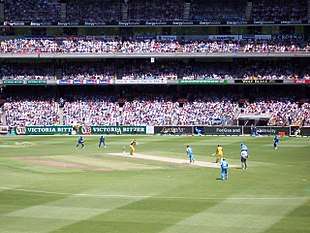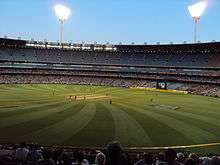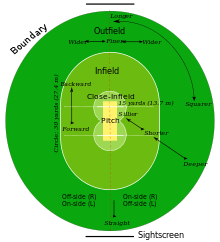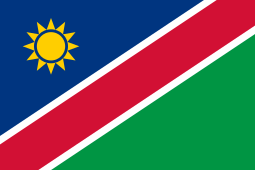One Day International
A One Day International (ODI) is a form of limited overs cricket, played between two teams with international status, in which each team faces a fixed number of overs, currently 50 (used to be 60 overs until 1983)[1]. The Cricket World Cup, generally held every four years, is played in this format. One Day International matches are also called Limited Overs Internationals (LOI), although this generic term may also refer to Twenty20 International matches. They are major matches and considered the highest standard of List A, limited-overs competition.
|
||||||||||||||||||||||||||||||||||||||||||||||||||||||||||||||||||||||||||||||||||||||||||||||||||||||||||||||||||||||||

The international one day game is a late-twentieth-century development. The first ODI was played on 5 January 1971 between Australia and England at the Melbourne Cricket Ground.[2] When the first three days of the third Test were washed out officials decided to abandon the match and, instead, play a one-off one day game consisting of 40 eight-ball overs per side. Australia won the game by 5 wickets. ODIs were played in white-colored kits with a red-colored ball.[3]
In the late 1970s, Kerry Packer established the rival World Series Cricket competition, and it introduced many of the features of One Day International cricket that are now commonplace, including colored uniforms, matches played at night under floodlights with a white ball and dark sight screens, and, for television broadcasts, multiple camera angles, effects microphones to capture sounds from the players on the pitch, and on-screen graphics. The first of the matches with coloured uniforms was the WSC Australians in wattle gold versus WSC West Indians in coral pink, played at VFL Park in Melbourne on 17 January 1979. This led not only to Packer's Channel 9 getting the TV rights to cricket in Australia but also led to players worldwide being paid to play, and becoming international professionals, no longer needing jobs outside cricket. Matches played with coloured kits and a white ball became more commonplace over time, and the use of white flannels and a red ball in ODIs ended in 2001.
The ICC, international cricket's governing body, maintains the ICC ODI Rankings for teams (see table on the right), batsmen, bowlers and all rounders. Currently, England are the top ranked ODI side.

| Part of a series on |
| Cricket |
|---|
Cricket pictogram |
Rules
In the main the Laws of cricket apply. However, in ODIs, each team bats for a fixed number of overs. In the early days of ODI cricket, the number of overs was generally 60 overs per side, and matches were also played with 40, 45 or 55 overs per side, but now it has been uniformly fixed at 50 overs.
Simply stated, the game works as follows:[4]
- An ODI is contested by two teams of 11 players each.
- The Captain of the side winning the toss chooses to either bat or bowl (field) first.
- The team batting first sets the target score in a single innings. The innings lasts until the batting side is "all out" (i.e., 10 of the 11 batting players are "out") or all of the first side's allotted overs are completed.
- Each bowler is restricted to bowling a maximum of 10 overs (fewer in the case of rain-reduced matches and in any event generally no more than one fifth or 20% of the total overs per innings). Therefore, each team must comprise at least five competent bowlers (either dedicated bowlers or all-rounders).
- The team batting second tries to score more than the target score in order to win the match. Similarly, the side bowling second tries to bowl out the second team or make them exhaust their overs before they reach the target score in order to win.
- If the number of runs scored by both teams is equal when the second team loses all its wickets or exhausts all its overs, then the game is declared a tie (regardless of the number of wickets lost by either team).
Where a number of overs are lost, for example, due to inclement weather conditions, then the total number of overs may be reduced. In the early days of ODI cricket, the team with the better run rate won (see Average Run Rate method), but this favoured the second team.[5] For the 1992 World Cup, an alternative method was used of simply omitting the first team's worst overs (see Most Productive Overs method), but that favoured the first team.[5][6] Since the late 1990s, the target or result has usually been determined by the Duckworth-Lewis-Stern method (DLS, formerly known as the Duckworth–Lewis method),[5] which is a method with statistical approach. It takes into consideration the fact that the wickets in hand plays a crucial role in pacing the run-rate and that a team with more wickets in hand can play way more aggressively than the team with fewer wickets in hand. When insufficient overs are played (usually 20 overs) to apply the DLS, a match is declared no result. Important one-day matches, particularly in the latter stages of major tournaments, may have two days set aside, such that a result can be achieved on the "reserve day" if the first day is washed out—either by playing a new game, or by resuming the match which was rain-interrupted.
Because the game uses a white ball instead of the red one used in first-class cricket, the ball can become discoloured and hard to see as the innings progresses, so the ICC has used various rules to help keep the ball playable. Most recently, ICC has made the use of two new balls (one from each end), the same strategy that was used in the 1992 and 1996 World Cups so that each ball is used for only 25 overs.[7] Previously, in October 2007, the ICC sanctioned that after the 34th over, the ball would be replaced with a cleaned previously-used ball.[8] Before October 2007 (except 1992 and 1996 World Cups), only one ball would be used during an innings of an ODI and it was up to the umpire to decide whether to change the ball.[4]
Fielding restrictions and powerplays

The bowling side is subjected to fielding restrictions during an ODI, in order to prevent teams from setting wholly defensive fields. Fielding restrictions dictate the maximum number of fielders allowed to be outside the thirty-yard circle.
Under current ODI rules, there are three levels of fielding restrictions:
- In the first 10 overs of an innings (the mandatory powerplay), the fielding team may have at most two fielders outside the 30-yard circle.[9]
- Between 11 and 40 overs four fielders will be allowed to field outside the 30-yard circle.[10]
- In final 10 overs five fielders will be allowed to field outside the 30-yard circle.[11][12]
History
Fielding restrictions were first introduced in the Australian 1980–81 season.[13] By 1992, only two fielders were allowed outside the circle in the first fifteen overs, then five fielders allowed outside the circle for the remaining overs.[14] This was shortened to ten overs in 2005, and two five-over powerplays were introduced, with the bowling team having discretion over the timing for both. In 2008, the batting team was given discretion for the timing of one of the two powerplays. In 2011, the teams were restricted to completing the discretionary powerplays between the 16th and 40th overs; previously, the powerplays could take place at any time between the 11th and 50th overs. Finally, in 2012, the bowling powerplay was abandoned, and the number of fielders allowed outside the 30-yard circle during non-powerplay overs was reduced from five to four.[4][15]
Trial regulations
The trial regulations also introduced a substitution rule that allowed the introduction of a replacement player at any stage in the match and until he was called up to play he assumed the role of 12th man. Teams nominated their replacement player, called a Supersub, before the toss. The Supersub could bat, bowl, field or keep wicket once a player was replaced; the replaced player took over the role of 12th man. Over the six months it was in operation, it became very clear that the Supersub was of far more benefit to the side that won the toss, unbalancing the game. Several international captains reached "gentleman's agreements" to discontinue this rule late in 2005. They continued to name Supersubs, as required, but they did not field them by simply using them as a normal 12th man. On 15 February 2006, the ICC announced their intention to discontinue the Supersub rule on 21 March 2006. 2 balls were trialed in ODI for 2 years but it was rejected[16]
Teams with ODI status
The International Cricket Council (ICC) determines which teams have ODI status (meaning that any match played between two such teams under standard one-day rules is classified as an ODI).
Permanent ODI status
The twelve Test-playing nations (which are also the twelve full members of the ICC) have permanent ODI status. The nations are listed below with the date of each nation's ODI debut after gaining full ODI status shown in brackets (Sri Lanka, Zimbabwe, Bangladesh, Ireland, and Afghanistan were ICC associate members at the times of their ODI debuts):
.svg.png)











Temporary ODI status
Between 2005 and 2017 the ICC granted temporary ODI status to six other teams (known as Associate members). In 2017 this was changed to four teams, following the promotion of Afghanistan and Ireland to Test status (and permanent ODI status). The ICC had previously decided to limit ODI status to 16 teams.[17] Teams earn this temporary status for a period of four years based on their performance in the ICC World Cup Qualifier, which is the final event of the ICC World Cricket League. In 2019, ICC increased the number of teams holding Temporary ODI status to eight. The following eight teams currently have this status (the dates listed in brackets are of their first ODI match after gaining temporary ODI status):








Additionally, eight teams have previously held this temporary ODI status before either being promoted to Test Status or relegated after under-performing at the World Cup Qualifier:

.svg.png)






The ICC occasionally granted associate members permanent ODI status without granting them full membership and Test status. This was originally introduced to allow the best associate members to gain regular experience in internationals before making the step up to full membership. First Bangladesh and then Kenya received this status. Bangladesh have since made the step up to Test status and full membership; but as a result of disputes and poor performances, Kenya's ODI status was reduced to temporary in 2005, meaning that it had to perform well at World Cup Qualifiers to keep ODI status. Kenya lost ODI status after finishing in fifth place at the 2014 Cricket World Cup Qualifier event.[18]
Special ODI status
The ICC can also grant special ODI status to all matches within certain high-profile tournaments, with the result being that the following countries have also participated in full ODIs, with some later gaining temporary or permanent ODI status also fitting into this category:


.svg.png)









Finally, since 2005, three composite teams have played matches with full ODI status. These matches were:
- The World Cricket Tsunami Appeal, a once-off match between the Asian Cricket Council XI vs ICC World XI in the 2004/05 season.
- The Afro-Asia Cup, two three-ODI series played in 2005 and 2007 Afro-Asia Cup between the Asian Cricket Council XI and the African XI.
- The ICC Super Series, a three-ODI series played between the ICC World XI and the then-top-ranked Australian cricket team in the 2005/06 season.

One Day records
See also
- ICC Test Championship
- ICC ODI Championship
- ICC T20I Championship
- Limited overs cricket
- One Day International records
- One Day International hat-tricks
- List of batsmen who have scored over 10000 One Day International cricket runs
- List of One Day International cricket umpires
References
- https://www.sportskeeda.com/cricket/5-changes-to-odi-rules-over-the-years
- Anthony Bateman; Jeffrey Hill (17 March 2011). The Cambridge Companion to Cricket. Cambridge University Press. p. 101. ISBN 978-0-521-76129-1.
- England in India 2011–12: MS Dhoni says it will be tricky adjusting to the new playing conditions | Cricket News | India v England Archived 16 October 2011 at the Wayback Machine. ESPN Cricinfo. Retrieved on 23 December 2013.
- "Standard One Day International match Playing Conditions" (PDF). International Cricket Council. Archived (PDF) from the original on 7 April 2014. Retrieved 6 April 2014.
- "The D/L method: answers to frequently asked questions". ESPN Cricinfo. September 2012. Archived from the original on 24 September 2015. Retrieved 16 January 2015.
- "The World Cup rain-rule farce". ESPN Cricinfo. 26 March 2011. Archived from the original on 16 January 2015. Retrieved 16 January 2015.
- "New rules to take effect from Oct 1". Cricbuzz. 1 October 2011. Retrieved 16 January 2015.
- "New cricket ball change rule gets thumbs down from Ponting". Cricbuzz. 16 October 2007. Retrieved 16 January 2015.
- "ICC gets rid of batting power play, five fielders allowed outside circle in last 10 overs of ODIs". Ibnlive.com. 27 June 2015. Archived from the original on 29 June 2015. Retrieved 14 June 2017.
- Nagraj Gollapudi. "Bowlers benefit from ODI rule changes | Cricket". ESPN Cricinfo. Archived from the original on 28 June 2015. Retrieved 14 June 2017.
- "ICC do away with Batting Powerplay in ODIs". Cricbuzz.com. Retrieved 14 June 2017.
- "ICC remove batting powerplays from ODIs to 'maintain a balance between bat and ball' | The National". Thenational.ae. 27 June 2015. Archived from the original on 30 June 2015. Retrieved 14 June 2017.
- "One-Day Cricket". CricTrivia.com. December 2005. Archived from the original on 9 February 2015. Retrieved 16 January 2015.
- "Colourful cricket, and that rain rule". ESPN Cric Info. Archived from the original on 21 June 2014. Retrieved 6 April 2014.
- "New ICC Rules for ODIs 2013". Archived from the original on 8 January 2013. Retrieved 2 February 2013.
- "ICC agrees to drop super-sub rule". BBC Sport. 20 March 2006. Retrieved 4 January 2015.
- ICC rule no change to ODI status for World Cup Qualifiers Archived 16 February 2018 at the Wayback Machine. ESPN Cricinfo. Retrieved on 16 February 2018.
- "Kenya to lose ODI member status". ESPNcricinfo. 18 March 2005. Archived from the original on 18 April 2018. Retrieved 18 April 2018.
External links
- NatWest International One Day Series
- International Cricket Rules and Regulations at the ICC website
- ICC Chief Executives' Committee approves introduction of ODI innovations by Jon Long, ICC website, 25 June 2005, retrieved 25 November 2005
- "ODI changes to take effect in NatWest Challenge" by Cricinfo staff, Cricinfo, 30 June 2005, retrieved 25 November 2005
- "Those new one-day rules explained" by Cricinfo staff, Cricinfo, 8 July 2005, retrieved 26 November 2005
_2017.svg.png)